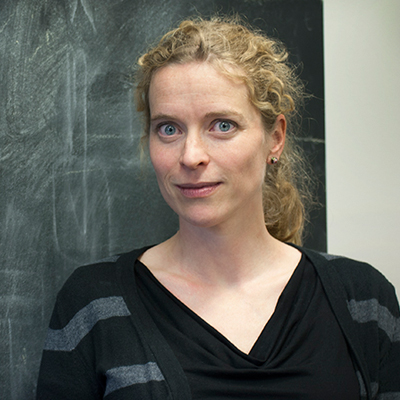Studying freshwater hydras' and planarians' abilities to regenerate for new brain therapies
Dr. Eva-Maria Schoetz Collins is applying physical principles and techniques to investigate the fundamental biological processes of development and regeneration, with a focus on the nervous system. Dr. Collins’ research is seeking answers to three important questions: 1. What is the role of mechanical interactions of cells and their environment for tissue and organ formation during early embryonic development, 2. How do environmental neurotoxins damage brain development and function, and what can we do to prevent or reverse it, and 3. What is the differentiation process of stem cells to neurons and how can new neurons integrate into existing circuits? Understanding how an initially unstructured suspension of cells is able to autonomously organize itself into separate tissues, organ systems, and ultimately organize a fairly complex organism has potential implications for tissue and organ engineering in the lab for use in humans. Deciphering the mechanism by which exposure to environmental toxins causes neurodevelopmental defects will help design better exposure guidelines for humans and inspire new preventive therapies. For neurons that cannot be salvaged and have been damaged or destroyed, understanding the process of neural regeneration via stem cells in planarians is crucial for understanding and controlling the process in humans. The hope is to one day to be able to use stem cells for regenerative therapies for currently incurable neuronal diseases such as Parkinson’s, Alzheimer’s, and motor-neuron diseases.
Dr. Eva-Maria Schoetz Collins, Assistant Professor of Physics and Cell and Developmental Biology at the University of California, San Diego is pursuing a quantitative approach to study fundamental biological problems pertaining to embryonic development and regeneration. Her research interests are threefold: First, she seeks to understand which factors govern early tissue and organ formation during embryonic development. For this study, her group uses freshwater hydra, which have the astounding capability of whole organism regeneration after complete dissociation into individual cells, allowing her team to study how an entire animal with a distinct body plan evolves de novo from a soup of cells. Second, in another regenerative organism, freshwater planarians, Dr. Collins is looking to decipher by which mechanisms environmental toxins impair development, specifically of the nervous system. Third, she is using the same organism to study neuronal repair after specific types of neurons have been chemically or optically ablated. Though these processes are being studied in relatively simple organisms, key genes and regulatory pathways are conserved between these animals and humans, and therefore the results garnered from these experiments can lead to conclusions applicable to human development.
Dr. Collins' current research is focused on three major questions:
- What is the role of mechanical interactions for cell migration, differentiation, and tissue formation?
-
Dr. Collins is trying to understand how pattern formation—how things grow from a single cell to a complex organism while forming different structures along the way—is achieved during development, and what the roles of physical interactions between cells and with the environment are for these processes. Experimental studies are conducted in one of the best regenerating organisms: the freshwater polyp Hydra, which autonomously self-organizes and regenerates after being completely dissociated into a suspension of single cells. In other words, one can stick hydras in a blender, make “Hydra soup” and from this blend a new animal will emerge within about a week! Because of their remarkable ability to regenerate, and their structural simplicity, Hydra regeneration is fully accessible for quantitative measurements and controlled chemical and mechanical perturbations while providing a relevant in vivo environment to make the measurements meaningful. Dr. Collins is combining quantitative measurements of mechanical properties and of cell behaviors with molecular biology experiments to determine which proteins and pathways are responsible for this remarkable self-organization of tissues during regeneration. Because fundamental mechanisms such as mechanical interactions operate in all animals, understanding a simple organism such as Hydra will help us understand this process in more complex organisms, including humans.
-
-
How can we effectively evaluate, prevent, and repair neuronal damage caused by environmental toxins?, and for structures not salvageable, how do stem cells coordinate to generate different types of neurons and reconnect to restore neuronal functions?
-
Dr. Collins’ lab has developed a custom screening assay that allows her team to study the influence of environmental neurotoxins, chemicals known to disrupt normal brain function, on brain development using freshwater planarians as a model system. Planarians are renowned for their regenerative capabilities which are based on adult pluripotent stem cells; if you cut a worm into 10 pieces, they will all regenerate into new little worms in about a week. This amazing feature allows Dr. Collins to generate animals that are all genetically identical for her toxin studies and thus distinguish between genetic and environmental factors which may influence their vulnerability to toxins. The planarians’ regeneration also allows her to induce brain development “at will” by amputation. To elucidate specific developmental neurotoxic effects, Dr. Collins’ group studies the effect of toxin exposure on adult and regenerating worms in parallel with the same assays, thus enabling a direct comparison of neurotoxicity in adult and developing brains. The planarian brain is much simpler than the human brain with only a few thousand neurons, yet it has sufficient complexity and similarity, sharing the same neuronal subpopulations and neurotransmitters, to be relevant for human studies. Thus, by studying the effect of toxins on planarian brain development, we can gain insight into key mechanisms for human brain development.
- Unfortunately, in real life one is often unaware of the toxins that they may be exposed to and thus following exposure guidelines is not always possible. Therefore, The Collins Lab is also investigating how neuronal damage could be repaired after it has occurred. Her team is developing assays to use chemical and optical means to destroy a neuronal subpopulation of interest and then study the regeneration dynamics of this population. Many of the tools from the neurotoxicity screen are useful for this research project, in particular behavioral readouts to assay neuronal function. Dr. Collins has three important goals in this project: (1) screen a large number of environmental toxins to determine their effects on brain development and compare her results with data from other organisms, which will in turn help develop better exposure guideline for humans. (2) For a group of selected neurotoxins, use planarians as a model to better understand the molecular mechanism underlying their neurotoxicity and use this information to help develop better antidotes if exposure cannot be prevented. (3) Finally, again taking advantage of the planarian’s ability to regenerate, Dr. Collins is seeking to understand how the worms repair neuronal damage after toxin removal using their stem cell population. Understanding these mechanisms in the worm may provide inspiration and insight for the development of stem-cell based therapies in the future.
-
Bio
Dr. Collins has always been curious about the nature and function of things, and early on she dreamed of becoming an explorer of sorts. When she was a child she first dreamed of becoming an archaeologist, then an astronaut, which culminated in Dr. Collins earning her undergraduate diploma in mathematics and physics. As a graduate student, she realized that understanding the basic principles by which living things gain their form and structure excited her most, and thus she focused on the application of physics for studying biological phenomena. Following this idea, she completed her Ph.D. work on the role of mechanical interactions of cells for cell migration and tissue formation during early embryonic development. For Dr. Collins, understanding how a complex organism can emerge from one single cell, the fertilized egg, has always been one of the most fascinating problems in biology. A related phenomena which sparks her imagination is regeneration, the ability of an organism to restore or reform lost body parts from existing tissue. Understanding how this is accomplished is exciting because not only would it mean answering one of the greatest questions in biology, it would also have tremendous medical applications. Imagine being able to grow new body parts from scratch following an accident! In fact, an entire field called “regenerative medicine” has recently emerged that is trying to utilize the power of stem-cell-based regeneration to restore function of damaged body parts and cure currently incurable diseases.
When Dr. Collins was pregnant with her son she was thrilled by the opportunity to experience human development firsthand, but was also concerned about his exposure to environmental toxins, knowing how vulnerable the developing embryo is. This personal experience prompted Dr. Collins to combine her two research interests, embryonic development and regeneration, to launch a new research program in summer 2014, i.e., to use freshwater planarians as a model system for developmental neurotoxicology. Because of the nature of their research, Dr. Collins' team is highly interdisciplinary and comprised of undergraduate and graduate students, postdocs, and even high school students from a range of fields, including physics, bioengineering, neuroscience, biochemistry, and molecular biology.
Dr. Collins is an avid proponent of Learning by Doing and she tries to expose students to research as early as possible. Therefore, in her lab, she has many undergraduate research assistants and even welcomes one to two high school students every year to join them for several weeks or months. In addition, she has designed a new course at UCSD that exposes incoming biology freshmen to a research-based lab in quantitative biology. While laboratory classes are an integral part of the undergraduate curriculum in biology at most universities, their focus is usually in teaching students by following established protocols and techniques. While Dr. Collins stresses the importance of these courses, real research, she also teaches different skills that students nowadays learn too late in their careers, such as critical thinking, experimental design, and how to find creative and practical solutions to difficult problems. In addition, her courses challenge the students to expand their quantitative and computational skills, a prerequisite for solving problems at the scientific interface between disciplines. To further prove her dedication to the idea, Dr. Collins has published several papers with undergraduate authors.
Outside the lab, Dr. Collins spends the majority of her time with her husband and her son, whom they recently welcomed into the world. Together they enjoy the outdoors as much as possible, running, hiking, or appreciating the beach, all often with their dog Spider by their side.


